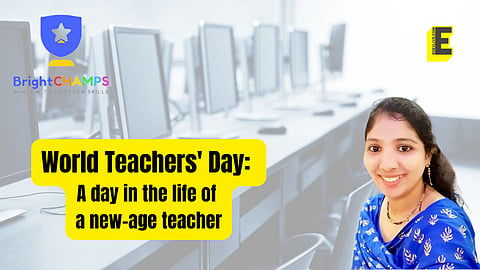

I’m often asked what a ‘typical’ day in a new-age teacher’s day looks like… And I always laugh and say, the only thing that is typical in a teacher’s day is that no two days are the same — especially when you’re teaching children of different ages from all over the world.
One day you could be eyeballs-deep in a conversation about ethical use of Artificial Intelligence (AI) and the biases of the creators of a tool becoming the foundational biases within the technology itself, and the very next day your students can be challenging you with how fashion tech can be refined to reduce waste within landfills. In case you’re wondering — I had both these things happen to me last week!
The age of technology
In the age of tech, it’s not just learning that is borderless — teaching, too, transcends borders. And each new culture and geography presents a unique set of challenges and opportunities for growth as a person, a teacher, and for my students.
Before I joined BrightCHAMPS, I used to be fluent in three languages. Today, I can understand common phrases, questions, and words from almost 10. And this is all because of all the different kinds of students and parents that have crossed my path in the last four years.
I can also confidently say that teaching kids from West, South East Asia, and the Middle East has made me a more well-rounded and global person — both as a teacher and on a personal level.
There was a time when my way of looking at the world was inadvertently narrow because I taught and interacted with a mostly homogenous group of students and parents. With borderless learning, that has completely turned on its head.
Now I daily get to witness the ways in which culture and a country’s international clout influence a child’s relationship with technology, money, what they consider to be the most burning global issues that require solving, climate, capitalism, business, and even language.
I get to witness the privilege of being able to take certain things for granted and how it changes the way the kids look at the world.
For example: I have students from very wealthy countries and families and also students from developing parts of the world, with parents who are spending a large chunk of the family’s income on education. I see how this knowledge changes the child’s idea of what success in the classroom means to them and their parents.
Exchange of ideas
It is truly humbling to watch, and all of us teachers who get to witness it try to take the best from all cultures and pass it along to students from other cultures. And I am delighted to say that all our students are better for this exchange of ideas and viewpoints.
To give you an example: Proficiency in the English language is a matter of great pride to a lot of my students in South East Asia (SEA), while it is taken completely for granted by my students in the United States (US), Canada, Australia, and Europe. Recently we had a rousing group discussion on accents and English, and I could practically see lightbulbs go off in the brains of my students from the West.
Since then, I’ve had three WIP app pitches to make language apps that are more inclusive. And that’s what borderless learning is all about — making the world a more connected, humane, and inclusive community.
All the wonderful and exciting changes aside, I do believe that the core of teaching remains the same in the era of tech and AI — leading children down a path of curiosity that makes them engage with the ‘hows’ and ‘whys’ that accompany every ‘what’ in the world.
Tech is just a tool, and rapid advancements in the field of tech have just made this journey of how and why even more exciting and personal for both teachers and students.
Train harder
At BrightCHAMPS, we've had to undergo dozens of hours of training in our AI-enabled platform that personalises and individualises learning for kids. What this means is that we now have the capability to be able to teach every child using the context, pace, format of learning/teaching, and subjects that best work for them.
For example: if my Class VII student can best write the use-case for a banking app by placing them in 19th-century pre-Independence India simulations because they are most interested in history and learn through immersion, we have the ability to do it.
But for that to happen seamlessly, I, as a teacher, need to understand this very powerful technology that I have. I need to know the extent of its capability and keep myself updated with every subsequent development, and also, crucially, be able to draw and discern what the data is telling me about my student — what are their strengths, weak spots, biases, and opportunity areas.
In that sense, it's a lot like the same process we use for our students — we also need to deeply understand the how and why of the technologies we are using instead of just knowing it operationally.
I believe data science is one of the most important new skills a new-age teacher has to know, regardless of the subject. All the tools we use are collecting and collating millions of fragments of data across the student journey that can give powerful insights to make the learning experience richer for that child, but only if teachers are equipped to understand data and not fear it.
Upskilling for teachers is not just learning 10 GPT prompts, it's about knowing what GPT is, what are its boundaries, why its prompts need to be phrased a certain way, what that certain way is, when not to use GPT, engaging with the ethical questions that surround AI, and so much more!
(Zareen Taj Syed is a Senior Coding Educator at BrightCHAMPS. Views expressed are her own)
